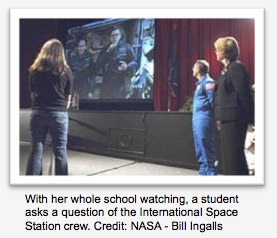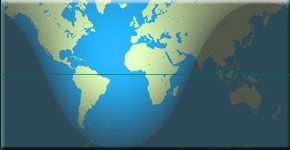Each summer, NASA Explorer Schools recognizes outstanding NES educators by providing an opportunity to attend an all-expense-paid, three- to five-day research experience. This summer, NES is hosting four research experiences.
On July 11, selected educators begin a week-long NASA Coastal Ocean Research Opportunity. Teachers become familiar with the science and research techniques used by NASA to study the coastal oceans, ocean color and Earth’s biosphere from space. They conduct research aboard research vessels and learn to use some of the same techniques used by NASA scientists.
The theme of the Solar System – Inside and Out summer experience is what is happening within our solar system and beyond. During this two-day professional development experience participants learn about our solar system, exoplanets, and the Hubble Space Telescope’s contributions to the study of these new worlds orbiting other stars. This workshop features science content presentations and hands- on activities that use real-world astronomical data and the Hubble Legacy Archive to bring the wonders of the universe to students. These activities can be implemented in the classroom to encourage students to generate relevant and meaningful research questions and search for new insights about the solar system. The “Solar System — Inside and Out” workshop will be held July 20-21, 2011, at the Space Telescope Science Institute, located on the Johns Hopkins University Homewood Campus in Baltimore, Md.
July 20 marks the first day of a four-day Water Filtration Research experience supporting the NES Engineering Design Challenge of the same name. Participants learn how NASA recycles water on the International Space System and about hydroponics and plant growth, as well as how a national park studies water.
A selected group of NES educators travel to the Goldstone Apple Valley Radio Telescope facility for a week-long research experience beginning on July 18. The GAVRT project uses a series of dedicated 34 meter (112 foot) radio telescopes at NASA’s Deep Space Network Goldstone Complex connected to classrooms via the Internet. Teachers acquire the curricular, operational and scientific knowledge to implement GAVRT within the classroom with cross-curricular lessons. Participants learn how to use the software. They are given access to the telescope for student use during the school year.
The final NES summer research experience, Forces and Motion, begins on August 1 and targets teachers of middle school students. Selected educators perform their own research on the properties of objects in a microgravity environment and then go through a design process to create and build a research experiment. The experience then culminates with testing the experiment in a NASA drop tower.
If you’d like to be eligible to participate in a NASA research experience next summer, become an NES participant by completing the registration form on the NES Virtual Campus.
Link to the NES Virtual Campus home page.
 During Expeditions 31 and 32, crew members aboard the International Space Station will participate in downlinks. Downlinks are approximately 20 minutes in length and allow students and educators to interact with astronauts through a question and answer session. Downlinks afford education audiences the opportunity to learn firsthand from astronauts what it is like to live and work in space. Downlinks are broadcast live on NASA TV and are streamed on the NASA website. Because of the nature of human spaceflight, organizations must demonstrate the flexibility to accommodate changes in downlink dates and times.
During Expeditions 31 and 32, crew members aboard the International Space Station will participate in downlinks. Downlinks are approximately 20 minutes in length and allow students and educators to interact with astronauts through a question and answer session. Downlinks afford education audiences the opportunity to learn firsthand from astronauts what it is like to live and work in space. Downlinks are broadcast live on NASA TV and are streamed on the NASA website. Because of the nature of human spaceflight, organizations must demonstrate the flexibility to accommodate changes in downlink dates and times. During Expeditions 31 and 32, crew members aboard the International Space Station will participate in downlinks. Downlinks are approximately 20 minutes in length and allow students and educators to interact with astronauts through a question and answer session. Downlinks afford education audiences the opportunity to learn firsthand from astronauts what it is like to live and work in space. Downlinks are broadcast live on NASA TV and are streamed on the NASA website. Because of the nature of human spaceflight, organizations must demonstrate the flexibility to accommodate changes in downlink dates and times.
During Expeditions 31 and 32, crew members aboard the International Space Station will participate in downlinks. Downlinks are approximately 20 minutes in length and allow students and educators to interact with astronauts through a question and answer session. Downlinks afford education audiences the opportunity to learn firsthand from astronauts what it is like to live and work in space. Downlinks are broadcast live on NASA TV and are streamed on the NASA website. Because of the nature of human spaceflight, organizations must demonstrate the flexibility to accommodate changes in downlink dates and times.
 Baltimore’s Maryland Science Center is going to be the “landing site” for the full-scale model of NASA’s James Webb Space Telescope, and it’s free for all to see.
Baltimore’s Maryland Science Center is going to be the “landing site” for the full-scale model of NASA’s James Webb Space Telescope, and it’s free for all to see.  NASA has a class assignment for U.S. students: help the agency give the twin GRAIL mission spacecraft headed to orbit around the moon new names.
NASA has a class assignment for U.S. students: help the agency give the twin GRAIL mission spacecraft headed to orbit around the moon new names. Vin Urbanowski, NASA Explorer Schools educator from the Academy of Information Technology & Engineering in Stamford, Conn., created a lesson, The Engineer Who Became an Artist: A
Vin Urbanowski, NASA Explorer Schools educator from the Academy of Information Technology & Engineering in Stamford, Conn., created a lesson, The Engineer Who Became an Artist: A 
 People in many countries throughout the world use satellite images and data. It’s important to be able to determine the exact time a picture was taken or data collected. To meet this need, satellites use a time stamp standard for tagging images and data — Universal Time, referred to as UT; or Zulu Time, designated by the letter Z; or Greenwich Mean Time, abbreviated as GMT. All three designations refer to the same time. The recorded time is the time at the 0º line of longitude, which runs through Greenwich, England.
People in many countries throughout the world use satellite images and data. It’s important to be able to determine the exact time a picture was taken or data collected. To meet this need, satellites use a time stamp standard for tagging images and data — Universal Time, referred to as UT; or Zulu Time, designated by the letter Z; or Greenwich Mean Time, abbreviated as GMT. All three designations refer to the same time. The recorded time is the time at the 0º line of longitude, which runs through Greenwich, England. The NASA Explorer Schools project is adding 20 new teaching modules throughout the coming year to cover even more science, technology, engineering and mathematics topics across grades 4-12. NES will post the first set of new resources, focused on mathematics for algebra 1, algebra 2 and calculus classrooms later this summer. Other new content modules will focus on concepts in life science, physical science, engineering, chemistry and Earth science.
The NASA Explorer Schools project is adding 20 new teaching modules throughout the coming year to cover even more science, technology, engineering and mathematics topics across grades 4-12. NES will post the first set of new resources, focused on mathematics for algebra 1, algebra 2 and calculus classrooms later this summer. Other new content modules will focus on concepts in life science, physical science, engineering, chemistry and Earth science.